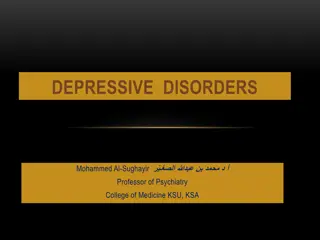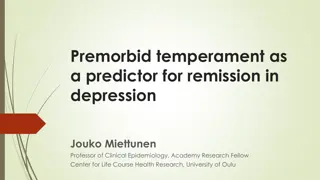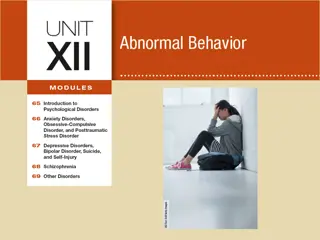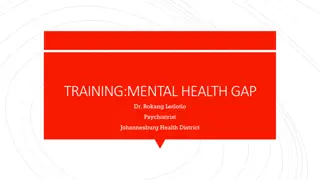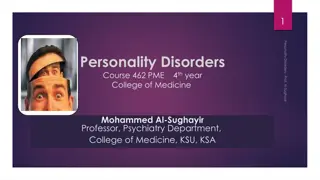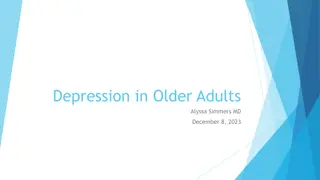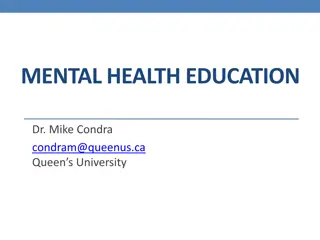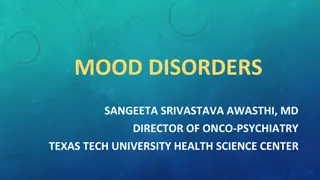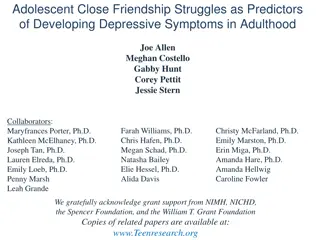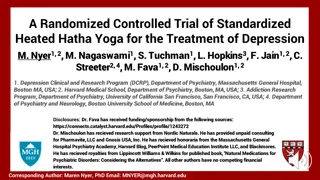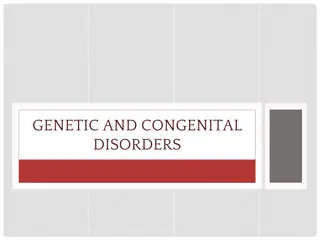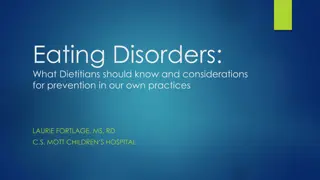Understanding Depressive Disorders: A Comprehensive Overview by Prof. Al-Sughayir
Explore the world of depressive disorders with Prof. Al-Sughayir as he delves into the definition, types, features, and etiology of depression. Learn about the case of Ms. Amal, a 27-year-old experiencing symptoms of depression, and understand the cognitive, mood, and behavioral changes associated with this condition.
Download Presentation

Please find below an Image/Link to download the presentation.
The content on the website is provided AS IS for your information and personal use only. It may not be sold, licensed, or shared on other websites without obtaining consent from the author. Download presentation by click this link. If you encounter any issues during the download, it is possible that the publisher has removed the file from their server.
E N D
Presentation Transcript
Depressive Disorders Mohammed Al-Sughayir Professor of Psychiatry College of Medicine KSU, KSA 1 19/11/35 Depressive Disorders - Prof. Al-Sughayir
Objectives To understand what depression is. To know the various types of depression. To recognize features of depression. To be aware of pathophysiology/etiology of depression. 2 19/11/35 Depressive Disorders - Prof. Al-Sughayir
Ms. Amal is a 27-year-old single woman works as a teacher. She has a five-week history of low mood, chest tightness, poor appetite, disturbed sleep, excessive guilt feelings, and loss of interest in her social activities. Healthy people have a wide continuum range of feelings with normal variations. [ usual sadness < < < - - - - - - - -> > > usual happiness ]. Patients with depression have : - Prolonged unusual sadness/lack of pleasure/others features that have adverse effect on functioning. - Body physiology is adversely affected (HPT axis). 3 19/11/35 Depressive Disorders - Prof. Al-Sughayir
Depression secondary to: Primary depression Medical d. (e.g., hypoth.). Persistent depressive d. Medications (e.g., OCPs). Major depressive d. Substance Abuse. Depressive episodes of bipolar d. Brain insult (e.g., CVA). Others. 4 19/11/35 Depressive Disorders - Prof. Al-Sughayir
Depressive features; range / analysis (cont.) Mood Changes: Unusual sadness (low mood). Anhedonia. Feeling lonely Irritability. 5 19/11/35 Depressive Disorders - Prof. Al-Sughayir
Depressive features; range / analysis Appearance & Behavior: Neglected dress and grooming. Facial appearance of sadness: Turning downwards of corners of the mouth. Down cast gaze/tearful eyes/reduced rate of blinking. Head is inclined forwards. Psychomotor retardation (in some patients agitation occurs): Lack of motivation and initiation. Slow movements/slow interactions. Social isolation and withdrawal. 6 19/11/35 Depressive Disorders - Prof. Al-Sughayir
Cognitive Functions & Thinking: Deficit in attention, concentration, memory, & decision making. In elderly this may be mistaken as dementia (pseudo dementia). Depressed thinking process Pessimistic thoughts) about Present: patient sees the unhappy side of every event (discounts any success in life, no longer feels confident, sees himself as failure). Past: unjustifiable guilt feeling and self-blame. Future: gloomy preoccupations; hopelessness, helplessness, death wishes (may progress to suicidal ideation and attempt). 7 19/11/35 Depressive Disorders - Prof. Al-Sughayir
Biological Features (Neuro-vegetative Signs): Change in appetite, wt., and sleep (usually reduced but in some patients increased). Fatigability, low energy level (simple task is an effort). Low libido and /or impotence. Change in bowel habit (usually constipation). Change in menstrual cycle (amenorrhea). Pain threshold becomes low (gate theory/serotonin). Several immunological abnormalities (e.g. low lymphocytes) increasing the risk to infection. 8 19/11/35 Depressive Disorders - Prof. Al-Sughayir
Etiology Bio-Psycho- Social. Neurotransmitters disturbances: 5HT-NE-DA. Genetic factors. 9 19/11/35 Depressive Disorders - Prof. Al-Sughayir
Persistent Depressive Disorder (Dysthymic Disorder) Diagnostic Criteria 2 years history of chronic low mood. No remission periods more than two months. During low mood there should be 2 out of the following: 1. low energy or fatigue. 2. low self-esteem. 3. feeling of hopelessness. 4.insomnia (or hypersomnia). 5.poor appetite (or overeating). 6. poor concentration or difficulty in making decisions. 10 19/11/35 Depressive Disorders - Prof. Al-Sughayir
Course and Prognosis The onset is usually insidious before age 25; the course is chronic. Some patients may consider early onset dysthymic disorder as part of life. Patients often suffer for years before seeking psychiatric help. About 25 percent never attain a complete recovery 11 19/11/35 Depressive Disorders - Prof. Al-Sughayir
Treatment of dysthymic disorder The most effective treatment is the combination of pharmacotherapy and cognitive or behavior therapy (CBT). A. Pharmacological: SSRI (e.g. fluoxetine 20 mg) SNRIs( e.g. venlafaxine 150 mg. These groups may be more beneficial than tricyclic drugs in the treatment of dysthymic disorders. B. Psychological: Cognitive therapy; to replace faulty negative self-image, negative attitudes about self, others, the world, and the future. Behavior therapy; to enable the patient to meet life challenges with a positive sense by altering personal behavior through implementing positive reinforcement. 12 19/11/35 Depressive Disorders - Prof. Al-Sughayir
Major Depressive Disorder ( MDD ) Presence of major depressive episodes(MDEs). There has never been a manic episode. Severity varies (mild-moderate- severe). 13 19/11/35 Depressive Disorders - Prof. Al-Sughayir
Epidemiology Lifetime prevalence is in the range of 15 - 25 %. The mean age of onset is about 40 years (25 - 50 years). It may occur in childhood or in the elderly. In adolescents, it may be precipitated by substance abuse. More common in those who lack confiding relationship (e.g. divorced, separated, single ). 14 19/11/35 Depressive Disorders - Prof. Al-Sughayir
Perinatal/Post-partum Depression About 10 - 15 %. In late pregnancy /within 6 weeks of childbirth (10 14 days after delivery). If not treated may continue for 6 months or more and cause considerable family disruption. It is associated with increasing age, mixed feelings about the baby, physical problems in the pregnancy and prenatal period, family distress and past psychiatric history. May be associated with irritability, self-blame and doubt of being a good mother, excessive anxiety about the baby s health and death wishes. Counseling, additional help with child-care may be needed. Antidepressants or ECT are indicated if there are biological features of depression. 15 19/11/35 Depressive Disorders - Prof. Al-Sughayir
Management of Major Depression: Bio-Psycho-Social Approach. Hospitalization is indicated for: Suicidal or homicidal patient. Patient with severe psychomotor retardation who is not eating or drinking (for ECT). Diagnostic purpose (observation, investigation ). Drug resistant cases (possible ECT). Severe depression with psychotic features (possible ECT). 16 19/11/35 Depressive Disorders - Prof. Al-Sughayir
Prognosis of Depression (MDD) About 25 % of patients have a recurrence within a year. About 10 % will eventually develop a manic episode. Be careful about antidepressants A group of patients have chronic course with residual symptoms and significant social handicap. 17 19/11/35 Depressive Disorders - Prof. Al-Sughayir


